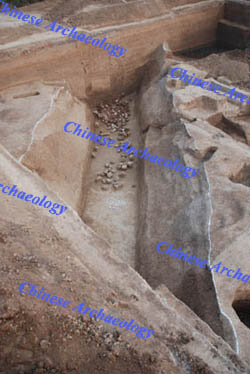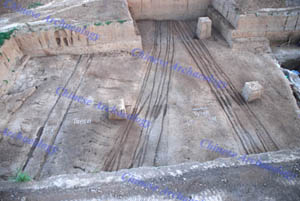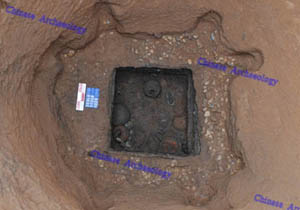The North Locus Site at Liujiazhuang in Yinxu, Anyang City, Henan Province
 From February to October of 2008, the Institute of Archaeology, Chinese Academy of Social Sciences, excavated the North Locus at the Liujiazhuang Village, to the south of the Xiaotun Palace/Temple zone across the Angang Avenue. Within the excavation zone, nearly 5000m2 in dimension, were found three roads with vehicle tracks, up to one hundred dwellings, over one thousand trash pits, twenty-seven trash ditches, and over forty storage pits, over twenty wells, one hoard of bronze vessels, and several sacrificial loci, all of which are of the Shang Dynasty, and 950 tombs of various dynasties as well. Accompanying them are found thousands of various artifacts made of various materials.
From February to October of 2008, the Institute of Archaeology, Chinese Academy of Social Sciences, excavated the North Locus at the Liujiazhuang Village, to the south of the Xiaotun Palace/Temple zone across the Angang Avenue. Within the excavation zone, nearly 5000m2 in dimension, were found three roads with vehicle tracks, up to one hundred dwellings, over one thousand trash pits, twenty-seven trash ditches, and over forty storage pits, over twenty wells, one hoard of bronze vessels, and several sacrificial loci, all of which are of the Shang Dynasty, and 950 tombs of various dynasties as well. Accompanying them are found thousands of various artifacts made of various materials.
The most important find of the Shang Dynasty are the roads with vehicle tracks, which consist of two running north-southward and one running east-westward. The roads are normally above 10m wide and over 20m wide at the greatest point. Our coring survey indicates that the north-south roads head toward the Xiaotun Palace/Temple Complex; they might have been the principal roads to the south of the complex. Their discovery enriches our knowledge of the layout of the Shang capital at Yinxu. The rammed-earth foundations, which date to all of the four occupation phases of the capital, are distributed along the principal roads. This layout appears to have been well planned.


The wells, ash pits, and storage pits are mostly scattered around the rammed-earth foundations. The wells are mostly rounded or elliptical but sometimes square or rectangular; they are very informative of ancient climate in the Huan River Valley, in which Yinxu is located. The ash pits are mostly irregular. A few of them, extraordinarily large in size, must have been originally used for quarrying earth but later for holding water. The fact that the surface around the pit is paved with gravels suggests that it might have been a pond in a garden. Some ash ditches, which are located along the principal roads, might have been sewage facilities; some ditches are rather wide and several hundred meters long and they might have been artificial ditches or territorial boundaries between lineage settlements or even defensive constructions.


The sacrificial remains are mostly distributed along the roads running east-westward and some are around foundations. Most of them are pit-like deposits, which contain ash and a large number of intact or dismembered humans and animals, or in some cases, large hoards of divinatory tortoise shells. The sacrificial animals in each pit might have represented one rite; and the types and quantity of sacrificial animals might have represented the assemblage of them.
The Shang tombs found at the designated locus are all middle- and small-sized ones. Scattered in groups, they do not constitute a cemetery.
During this season of excavation, scientists of various disciplines were invited to take part in field operations; together with excavators, they gathered a large amount of faunal and botanical materials, and nearly 3000 radiocarbon specimens, which are important for studying the Shang Dynasty ecology in the Huan River Valley region. Translated by Zhang Liangren

